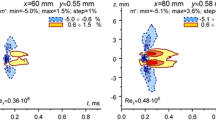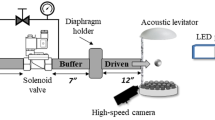Abstract
A number of experimental results that could not be satisfactorily explained within the framework of the Grib—Zel'dovich—Neumann—Döring detonation theory are reviewed, namely, the oscillating detonation of some liquid high explosives (HE), the weak dependence of the time of detonation transformation of heterogeneous charges on their structure (particle size, liquid or solid state, etc.) with a strong dependence of the critical diameter of detonation on the structure, and the extremely weak dependence of the detonation rate of liquid HE on the charge diameter with a significant value of the critical diameter of detonation. These studies yielded the following results: 1) for each heterogeneous HE, a typical shock–wave pressure p * and a typical initial density ρ0 * were found, such that, for their low values, HE transformation follows the mechanism of hot points (depends on the charge structure), and for high values of these parameters, HE transformation obeys the homogeneous mechanism (does not depend on the charge structure); 2) two new theoretical notions were discovered and used in the detonation theory: the phenomenon of breakdown of the chemical reaction in the shock–wave front by rarefaction waves and the notion of a “shock jump,” which reflects the specific character of action of shock waves on complex multiatomic molecules of condensed HE. It was also shown that the discovery of the parameters p * and ρ0 * and the breakdown and “shock jump” phenomena allowed one to confirm experimentally the explanations of the above observations, which are incompatible with the Grib—Zel'dovich—Neumann—Döring detonation theory, to propose the structure of the front of detonation waves both in homogeneous (stable and oscillating) and heterogeneous HE whose basic property is HE transformation (partial or complete depending on the HE power and initial density) already in the shock–wave front, and to proposed principally new ideas on the nature of the critical diameter of detonation of homogeneous and heterogeneous HE.
Similar content being viewed by others
REFERENCES
E. Mallard and H. L. Le Chatelier, “Recherches experimentales et théoriques sur la combustion des melanges gazeux explosifs-memoire i, temperature d'inammation des melanges gazeux,” Ann. Mines, 4, No. 8, 274–295 (1883).
M. Berthelot and P. Vieille, “L'oude explosive,” Ann. Chem. Phys., 28, No. 5, 283–332 (1883).
V. A. Michelson, “Normal ignition rate of explosive gas mixtures,” in: Scientific Papers of the Imperial Moscow University in Mathematics and Physics [in Russian], Vol. 10 (1893), pp. 1–93.
D. L. Chapman, “On the rate of explosions in gases,” Phil. Mag., 47, 90–104 (1899).
E. Jouguet, “On the propagation of chemical reaction in gases,” J. Math. Pures Appl., 7, 347–425 (1905); 2, 5–86 (1906).
A. A. Grib, “Hydrodynamic theory of explosive waves,” Candidate's Dissertation in Phys-Math. Sci., Tomsk Univ. (1940); Prikl. Mekh. Mat., 8, No. 4, 273 (1944).
Ya. B. Zel'dovich, “Theory of propagation of detonation in gas systems,” Zh. Éxp. Teor. Fiz., 10, No. 5, 542–568 (1940).
J. von Neumann, “Theory of DetonationWaves (OD-02),” Technical Report, National Defense Research Committee of the Office of Scientific Research and Development, Division B, Section B-1, Serial No. 238 (1942).
W. Döring, “Uber der detonation vergang in gasen,” Ann. Phys., 43, No. 5, 421–436 (1943).
E. N. Aleksandrov, V. A. Veretennikov, A. N. Dremin, and K. K. Shvedov, “Mechanism of detonation of porous HE,” Fiz. Goreniya Vzryva, 3, No. 4, 471–484 (1967).
K. K. Shvedov and S. A. Koldunov, Effect of the Physical State and Charge Structure on the Time of Their Response upon Detonation [in Russian], Nauka, Moscow (1972), pp. 439–443.
V. O. Rosing and Yu. B. Khariton, “HE detonation with small charge diameters,” Dokl. Akad. Nauk SSSR, 26, No. 4, 360–361 (1940).
H. Eyring, R. E. Powell, G. H. Duffet, and R. B. Paril, “The stability of detonation,” Chem. Rev., 45, 69–181 (1949).
L. V. Dubnov, “Problem of losses in a detonation wave,” Zh. Fiz. Khim., 34, 2367 (1960).
M. W. Evans, “Detonation sensitivity and failure diameter in homogeneous condensed materials,” J. Chem. Phys., 36, 193–200 (1962).
G. G. Rempel, “Estimation of the width of the chemical reaction zone in detonation waves,” Vzryv. Delo, 52, No. 9, 39–56 (1963).
A. N. Dremin, S. D. Savrov, V. S. Trofimov, and K. K. Shvedov, Detonation Waves in Condensed Media [in Russian], Nauka, Moscow (1970).
A. N. Dremin, “On condensed explosives detonation decomposition mechanism,” in: Proc. of the Symp. (Int.) on High Dynamic Pressure, Paris (1978), pp. 175–182.
A. N. Dremin and K. K. Shvedov, “On shock wave explosive decomposition,” in: Proc. of the 6th Symp. (Int.) on Detonation, San Diego, Aug. 24–27 (1976), pp. 29–35.
A. N. Dremin, Toward Detonation Theory, Springer, New York (1999).
A. N. Dremin and V. S. Trofimov, “Structure of the front of nonideal detonation in solid HE,” Fiz. Goreniya Vzryva, 7, No. 3, 427–428 (1971).
K. M. Mikha'lyuk and V. S. Trofimov, “Possible gasdynamic limit of propagation of steady detonation,” Fiz. Goreniya Vzryva, 13, No. 4, 606–613 (1977).
I. F. Kobylkin and V. S. Solov'ev, “Equation of the shape of the nonideal detonation wave front and the ow structure inside the chemical reaction zone,” in: Mechanics of Pulsed Processes [in Russian], Bauman Tech. Univ. (1985), pp. 55–66.
K. I. Shchelkin and Ya. K. Troshin, Combustion Gas Dynamics [in Russian], Izd. Akad. Nauk SSSR, Moscow (1963).
A. N. Dremin, G. A. Adadurov, and O. K. Rozanov, “Detonation of nitromethane near the limit,” Dokl. Akad. Nauk SSSR, 133, No. 6, 1372–1374 (1960).
A. N. Dremin and O. K. Rozanov, “Detonation of nitromethane-acetone mixtures,” Dokl. Akad. Nauk SSSR, 139, No. 1, 137–139 (1961).
K. I. Shchelkin, “Two types of unstable combustion,” Zh. Éxp. Teor. Fiz., 36, 600–606 (1959).
V. V. Voitsekhovskii, V. V. Mitrofanov, and M. E. Topchiyan, Detonation Front Structure in Gases [in Russian], Izd. Sib. Div. Akad. Nauk SSSR, Novosibirsk (1963).
R. I. Soloukhin, Shock Waves and Detonation in Gases [in Russian], Fizmatgiz, Moscow (1963).
K. I. Shchelkin, Detonation [in Russian], Nauka, Moscow (1968).
A. N. Dremin, “Critical diameter of detonation of liquid HE,” Dokl. Akad. Nauk SSSR, 147, 870–873 (1962).
A. N. Dremin and S. D. Savrov, “Limiting conditions of stable propagation of stable detonation of liquid HE,” Fiz. Goreniya Vzryva, No. 4, 75 (1966).
D. A. Frank-Kamenetskii, Diffusion and Heat Transfer in Chemical Kinetics [in Russian], Nauka, Moscow (1987).
S. A. Koldunov, “Effect of density on transitional processes with shock-wave initiation,” in: Shock Waves in Condensed Media [in Russian], St. Petersburg (1998), p. 93.
A. N. Dremin, V. Yu. Klimenko, O. N. Davidova, and T. A. Zoludeva, “Multiprocess detonation model,” in: Proc. of the 9th Symp. (Int.) on Detonation, Portland, Oregon, Aug. 28-Sept. 1 (1989), pp. 725–728.
A. N. Dremin and L. V. Babare, Shock Waves in Condensed Matter, Am. Inst. of Phys., New York (1981), pp. 363–381.
S. Block, C. E. Weir, and P. J. Piermarini, “Polymorphism in benzene, naphthalene and anthracene at high pressure,” Science, 169, 586–587 (1970).
V. K. Ashaev, G. S. Doronin, and A. D. Levin, “Detonation front structure in condensed high explosives,” Fiz. Goreniya Vzryva, 24, No. 1, 95–99 (1988).
S. V. Pershin and A. V. Utkin, “Evolution of the pro-file of the steady zone of the detonation wave with increasing initial density of 2' 2' 2'-trinitroethyl-4; 4; 4-trinitrobutyrate,” in: Abstracts of XII Symp. on Combustion and Explosion, Chernogolovka, Sept. 11–15 (2000).
A. V. Utkin, “Effect of initial density on the structure of detonation waves in heterogeneous HE,” ibid.
W. Fikett, Introduction to Detonation Theory, Univ. of Calif. Press, Berkeley-Los Angeles-London (1985).
Yu. B. Zel'dovich and A. S. Kompaneets, Detonation Theory [in Russian], Gostekhizdat, Moscow (1955).
Author information
Authors and Affiliations
Rights and permissions
About this article
Cite this article
Dremin, A.N. Discoveries in Detonation of Molecular Condensed Explosives in the 20th Century. Combustion, Explosion, and Shock Waves 36, 704–715 (2000). https://doi.org/10.1023/A:1002846521218
Issue Date:
DOI: https://doi.org/10.1023/A:1002846521218




